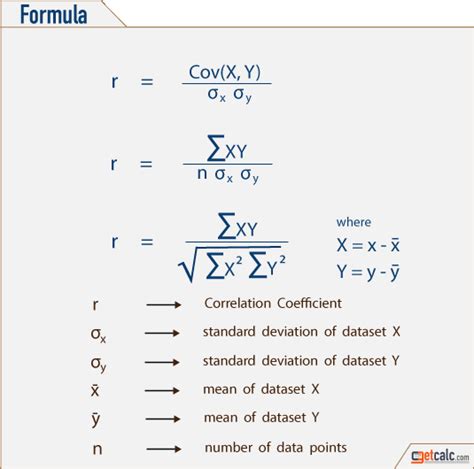How to Calculate the Correlation Coefficient: A Step-by-Step Guide
Understanding correlation is crucial in statistics. It helps us determine the relationship between two variables. This guide will walk you through calculating the Pearson correlation coefficient, the most commonly used measure of linear correlation.
What is a Correlation Coefficient?
The correlation coefficient, often denoted as 'r', measures the strength and direction of a linear relationship between two variables. The value of 'r' always falls between -1 and +1:
- r = +1: Indicates a perfect positive correlation. As one variable increases, the other increases proportionally.
- r = -1: Indicates a perfect negative correlation. As one variable increases, the other decreases proportionally.
- r = 0: Indicates no linear correlation. There's no linear relationship between the variables, although a non-linear relationship might exist.
- Values between -1 and +1: Represent varying degrees of correlation, with values closer to -1 or +1 indicating stronger correlations.
Calculating the Pearson Correlation Coefficient: A Step-by-Step Approach
Let's break down the calculation process. We'll use the following data set as an example:
| X | Y |
|---|---|
| 1 | 2 |
| 2 | 3 |
| 3 | 5 |
| 4 | 6 |
| 5 | 8 |
Step 1: Calculate the Mean of X and Y
The mean (average) of X and Y are calculated as follows:
- Mean of X (X̄): (1 + 2 + 3 + 4 + 5) / 5 = 3
- Mean of Y (Ȳ): (2 + 3 + 5 + 6 + 8) / 5 = 4.8
Step 2: Calculate the Deviation Scores
For each data point, subtract the mean of its respective variable:
| X | Y | X - X̄ | Y - Ȳ |
|---|---|---|---|
| 1 | 2 | -2 | -2.8 |
| 2 | 3 | -1 | -1.8 |
| 3 | 5 | 0 | 0.2 |
| 4 | 6 | 1 | 1.2 |
| 5 | 8 | 2 | 3.2 |
Step 3: Calculate the Product of Deviation Scores
Multiply the deviation scores for each data point:
| X | Y | X - X̄ | Y - Ȳ | (X - X̄)(Y - Ȳ) |
|---|---|---|---|---|
| 1 | 2 | -2 | -2.8 | 5.6 |
| 2 | 3 | -1 | -1.8 | 1.8 |
| 3 | 5 | 0 | 0.2 | 0 |
| 4 | 6 | 1 | 1.2 | 1.2 |
| 5 | 8 | 2 | 3.2 | 6.4 |
Step 4: Calculate the Sum of the Product of Deviation Scores
Sum up the values from the last column:
Σ(X - X̄)(Y - Ȳ) = 5.6 + 1.8 + 0 + 1.2 + 6.4 = 15
Step 5: Calculate the Sum of Squared Deviations for X and Y
Calculate the sum of squared deviations for both X and Y separately:
- Σ(X - X̄)²: (-2)² + (-1)² + 0² + 1² + 2² = 10
- Σ(Y - Ȳ)²: (-2.8)² + (-1.8)² + 0.2² + 1.2² + 3.2² = 20
Step 6: Calculate the Correlation Coefficient (r)
Finally, calculate 'r' using the following formula:
r = Σ(X - X̄)(Y - Ȳ) / √[Σ(X - X̄)² * Σ(Y - Ȳ)²]
r = 15 / √(10 * 20) = 15 / √200 ≈ 1.06
Important Note: In this example, we obtained r ≈ 1.06. However, a correlation coefficient should always be between -1 and +1. A value outside this range suggests a calculation error. Double-check your calculations to ensure accuracy.
Using Software and Tools
Calculating correlation coefficients manually can be tedious, especially with large datasets. Statistical software packages like SPSS, R, and Excel provide functions to easily calculate correlation coefficients.
Beyond the Basics: Understanding Limitations
While the correlation coefficient is a powerful tool, remember its limitations:
- Correlation does not equal causation: A strong correlation doesn't prove that one variable causes changes in the other.
- Linearity: The Pearson correlation coefficient only measures linear relationships. Non-linear relationships might exist even if 'r' is close to 0.
- Outliers: Outliers can significantly influence the correlation coefficient.
By following these steps and understanding the limitations, you can effectively calculate and interpret correlation coefficients to analyze relationships within your data. Remember to always double-check your calculations and consider using statistical software for efficiency.
